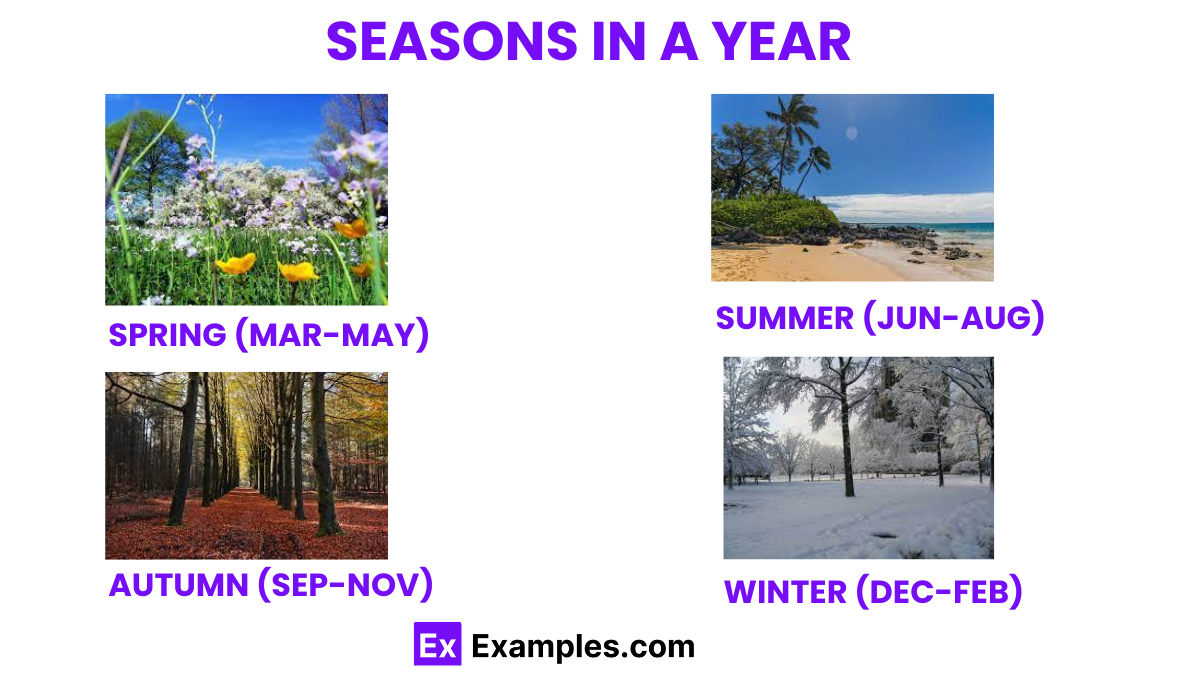Season Names: Meaning
The rhythm of the Earth’s journey around the Sun gifts us the beauty of the seasons: Spring, Summer, Autumn, and Winter. Each season, with its unique name, carries a distinct essence and unfolds a chapter of nature’s perpetual story. These names are not just markers of time; they are steeped in history, mythology, and cultural significance, reflecting humanity’s deep connection with the natural world. From the rejuvenating embrace of Spring to Winter’s serene repose, the cycle of seasons paints the canvas of our planet with diverse hues of life and transformation.
What are seasons?
Seasons are distinct periods of the year characterized by unique weather patterns, temperatures, and day lengths, resulting from the Earth’s axial tilt and its orbit around the Sun. The four main seasons—Spring, Summer, Autumn (or Fall), and Winter—each bring different environmental changes and influence the natural world and human activities. These seasonal cycles have profound effects on plant life, animal behavior, and various human cultural and social practices.
Seasons in a Year
| Season Name | Duration | Old Name |
|---|---|---|
| Spring | March – May | Lent |
| Summer | June – August | Aestas |
| Autumn | September – November | Harvest |
| Winter | December – February | Winterfylleth |
Spring
Spring, originating from the Old English word “springan,” meaning to leap or burst forth, symbolizes rebirth and renewal. This season marks the transition from the cold of winter to the warmth of summer. It is characterized by the blossoming of flowers, the budding of trees, and the return of birds and wildlife, signifying fertility and new beginnings. Culturally, spring is celebrated worldwide through festivals like Easter and Holi, which reflect themes of rejuvenation, growth, and joy.
Summer
Summer, derived from the Old English “sumor,” represents warmth and abundance. It is the season of longest days and shortest nights, associated with outdoor activities, vacations, and a general sense of leisure and relaxation. Historically, summer was crucial for agriculture, allowing for the growth and harvest of crops, essential for survival. Today, it continues to be a time for growth and productivity in many aspects of life, celebrated through events like the Summer Solstice, emphasizing the season’s peak and the fullness of life.
Autumn
Autumn, known as “harvest” in Old English, reflects the season of gathering mature crops from the fields. It’s a period of transition from the heat of summer to the chill of winter, marked by the changing colors of leaves and the harvest of produce. Autumn is significant for its symbolism of change, balance, and preparation for the winter ahead. Cultural celebrations like Thanksgiving and the Mid-Autumn Festival honor the season’s bounty and the importance of gratitude and family.
Winter
Winter, from the Old English “winter,” is the coldest season, characterized by shorter days, longer nights, and often snowfall. It’s a time of dormancy and introspection, where many plants and animals slow down or hibernate to conserve energy. Historically, winter was a challenging season, demanding preparation and resilience. Today, it’s embraced through holidays like Christmas and New Year, which bring warmth and light to the darkest time of the year, fostering community and celebration amidst the cold.
How Seasons Occurred
- Earth’s Axial Tilt: Seasons occur primarily due to the Earth’s axis being tilted about 23.5 degrees relative to its orbital plane around the Sun.
- Orbital Movement: As the Earth orbits the Sun, the tilt causes different hemispheres to receive varying amounts of sunlight throughout the year.
- Sunlight Intensity: The angle at which sunlight hits the Earth affects its intensity. When the Sun is directly overhead, the energy is more concentrated, leading to warmer temperatures.
- Solstices and Equinoxes: The tilt and orbit result in solstices and equinoxes, which mark the beginnings of the seasons. The summer solstice has the longest day, the winter solstice the shortest, and equinoxes have equal day and night lengths.
- Hemispherical Differences: When one hemisphere experiences summer, the other experiences winter, and vice versa, due to the tilt directing more sunlight to one hemisphere.
- Geographical Variation: The intensity and duration of seasons can vary significantly based on geographical location, especially between the equator and the poles.
- Atmospheric Conditions: Seasonal changes also influence weather patterns and atmospheric conditions, leading to the typical weather associated with each season.
Season Names for Babies
| Baby Girl Names | Meaning | Baby Boy Names | Meaning |
|---|---|---|---|
| Ava | Like a bird, representing spring | Leo | Lion, symbolizing summer’s strength |
| June | After the month, signaling summer | August | Revered, reflecting the warmth of summer |
| Autumn | After the season, evoking fall’s richness | Rowan | Tree with red berries, reminiscent of autumn |
| Ivy | A plant that thrives in winter | Asher | Happiness, associated with the joy of harvest season |
| Daisy | A fresh, spring flower | Jasper | Gemstone, echoing the earthy tones of autumn |
| Summer | After the sunny season | Julian | Youthful, capturing the essence of spring |
| Hazel | The color of autumn leaves | Forrest | After the forest, symbolizing nature’s depth |
| Snow | For winter’s pristine beauty | Frost | Reflecting the chill and beauty of winter |
| May | The month of growth and spring | Phoenix | Mythical bird, symbolizing renewal like spring |
| Willow | Tree, signifying grace and flexibility | Gale | A strong wind, often associated with March |
| Aurora | Dawn, bringing light like spring | Orion | Constellation, representing winter’s night sky |
| Ruby | Precious stone, vibrant like summer | Oak | Strength and endurance, like the robust nature of all seasons |
| Sierra | Mountain range, evoking the grandeur of nature | Reed | A plant that sways with the breeze, symbolizing adaptability |
| Brooke | A small stream, symbolizing the flow of seasons | Heath | A tract of open land, evoking the openness of summer fields |
Causes and Effects of Season Names
The naming of seasons is deeply rooted in human culture and history, reflecting our attempt to understand and articulate the cyclical patterns of nature. These names are not just arbitrary labels; they carry significant meanings and implications that have evolved over centuries, influenced by various factors including geography, climate, and societal norms.
Causes for Season Names:
- Agricultural Practices: Early civilizations named seasons based on farming cycles, like planting or harvesting times, which were crucial for survival.
- Astronomical Events: The position of the Earth relative to the Sun, including solstices and equinoxes, played a key role in defining the characteristics of each season.
- Cultural Beliefs: Mythology and religion influenced season names, with gods and goddesses often representing seasonal changes and natural phenomena.
- Environmental Changes: Observable changes in weather, flora, and fauna across different times of the year led to distinct names that reflect these transformations.
Effects of Season Names:
- Behavioral Adaptations: Season names have guided human activities, from agricultural practices to cultural festivals, shaping lifestyles and societal structures.
- Psychological Impact: The transition between seasons can affect mood and behavior, influencing social dynamics and individual well-being.
- Economic Implications: Seasons drive economic activities, particularly in sectors like agriculture, tourism, and retail, dictating market demands and labor cycles.
- Cultural Identity: Season names contribute to cultural identity and heritage, encapsulating the relationship between humans and their environment through traditions and folklore.
What are the 6 Seasons in India Climate?
India’s climate includes six traditional seasons: Spring (Vasant), Summer (Grishma), Monsoon (Varsha), Autumn (Sharad), Pre-Winter (Hemant), and Winter (Shishir).
What is the Best Season of the Year?
The best season is subjective and varies by personal preference; some enjoy the warmth of Summer, while others prefer the coolness of Autumn or Winter.
How Many Countries Have Six Seasons?
A few countries, including India and Bangladesh, traditionally recognize six seasons, aligning with their unique climatological and cultural practices.
In conclusion, season names are not merely labels but a reflection of nature’s rhythmic dance, deeply intertwined with human culture and history. From the rejuvenating Spring to the contemplative Winter, each season carries its unique essence and narrative. Understanding these names enriches our appreciation of the natural world and our place within its perpetual cycle, connecting us more deeply to the Earth’s ever-changing beauty



